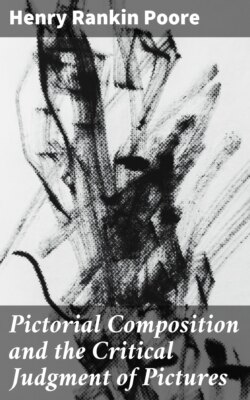Читать книгу Pictorial Composition and the Critical Judgment of Pictures - Henry Rankin Poore - Страница 13
На сайте Литреса книга снята с продажи.
BALANCE BY OPPOSITION OF LINE.
ОглавлениеTable of Contents
A series of oppositional lines has more variety and is therefore more picturesque than the tangent its equivalent. The simplest definition of [pg 49] picturesqueness is variety in unity. The lines of the long road in perspective offer easy conduct for the eye, but it finds a greater interest in threading its way over a track lost, then found, lost and found again. In time we as surely arrive from a to z by one route as by the other, but in one the journey has had the greater interest.
Imagine a hillside and sky offered as a picture. The hillside is without detail, the sky a blank. The first item introduced attracts the eye, the second and third are joined with the first. If they parallel the line of the hillside they do nothing toward the development of the picture but rather harm by introducing an element of monotony. If, however, they are so placed in sky and land as to accomplish opposition to this line they help to send the eye on its travels.
No better example of this principle can be cited than Mr. Alfred Steiglitz's pictorial photograph of two Dutch women on the shore. The lines of ropes through the foreground connect with others in the middle distance leading tangentially to the house beyond.
To one who fences or has used the broad sword a feeling for oppositional line should come as second nature. A long sweeping stroke must be parried or opposed frankly; the riposte must also be parried. A bout is a picturesque composition of two men and two minds in which unity of the whole and of the parts is preserved by the balance of opposed measures. The analogy is appropriate. The artist stands off brush in hand [pg 51] and fights his subject to a finish, the force of one stroke neutralizing and parrying another. This is as true of linear as color composition, where the scheme is one producing harmony by opposition of colors.
In the photograph of the Indian and horse we have a subject full of fine quality. The demonstration occurs in the sky at just the right place to serve as a balance for the heavy measures of the foreground and the interest is drawn back into the picture and to the upper left hand corner by the two cloud forms, over which is sharply thrown a barricade of cloud which turns the vision back into the picture. The simplicity of the three broad tones is appropriate to the sentiment of vastness which the picture contains. The figure seated in revery before this expanse supplies the mental element to the subject, the antithesis of which is the interest of the horse, earthward. Each one has his way, and in the choice by each is the definition of man and brute, a separation which the pose of each figure indicates through physical disunion. The space between them widens upon the horizon line. To establish the necessary pictorial connection or at least a hint of it suggests three devices. A lariat in a curving line might be slightly indicated [pg 52] through the grass: the foreground might be cut so as to limit the range toward us; or a broken line may be constructed diagonally from the horse's left foot by a few accents in the light of the stubble. In the first, the union is effected by transition of line; in the last by opposition of the spot of the figure to the line of the horse's shoulder and leg extended by a line through the grass.
With the coalition of these two figures there would no longer be felt a procession of three items in a straight perspective line: the horse, the man, and the distant river. Instead it would be the horse and owner over against the notion of prairie, river, and sky.
